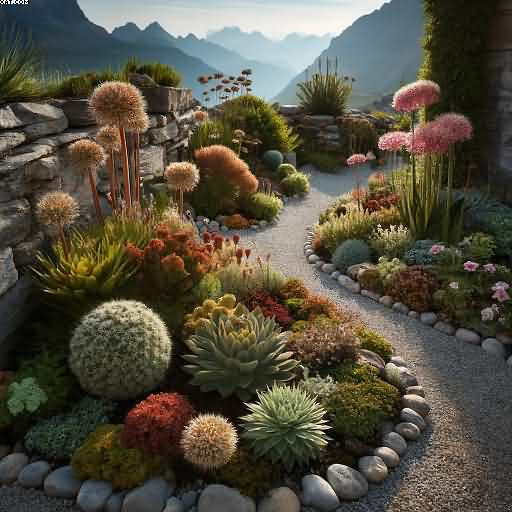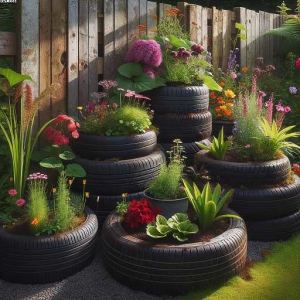Planting out a wall garden
Table of contents
Planting out a wall garden

Planting out a wall garden
My interest in the wall geardens came from the beautiful gardens that stuck in my mind as a child growing up here in Yorkshire. Importantly, every year, we would go on a school trip either to the Yorkshire dales or the Lake District. Happily, I will never forget the beautiful cottage gardens that adorned most village gardens in this part of the world.
Subsequently, these school trips set a precedent and an interest in gardening that would stay with me for the rest of my life. Consequently, because of these trips, I have a complete love of nature and all wildlife. Beautiful walls were planted with spring-flowering plants that cascaded from the top of the small garden walls. My first love was for the vibrant purple flowers of Aubretia. Probably one of the first plants to flower. Naturally, sedums were also popular and seemed to prosper in the dry and well-drained conditions of the walls.
Moving forward forty odd years, I decided to build a low wall down the length of my drive here in Mirfield, West Yorkshire. The wall had two purposes ! The first was to stop delivery cars and vans from turning on my lawn. The second was to create a wall garden.
The twin walls were filled with top soil mixed with fine gravel for good drainage and planted with many alpine plants. I then topped the plants with small pieces of gravel for drainage.
The Best Plants for Your Wall Garden: Embrace Vertical Gardening
Vertical gardens, also known as wall gardens, are an excellent way to add some greenery to cramped areas. These vertical gardens can turn any area into a verdant sanctuary, whether it’s a little patio, a balcony, or just a lifeless wall that needs some greenery. They’re also ideal for those of us who have little garden space and live in cities. Now let’s explore some of the top plants that can be grown in UK wall gardens.
1. Ferns: The Timeless Option- Planting out a wall garden
For wall gardens, ferns are a good choice, especially in partially or completely shaded areas. Their tiny fronds give the scene a lush, textural quality. For vertical planting, fern varieties such as Maidenhair Fern and Hart’s Tongue Fern work particularly well. They can withstand the colder UK environment and grow best in soil that is wet and well-drained.
2. Succulents: Beauties with Minimal Upkeep
Succulents require very little upkeep and are perfect for sunny areas. Their many hues and forms can combine to produce a powerful visual impact. Think about the hardy Sedum (Stonecrop) and Sempervivum (Houseleeks), which are ideal for wall gardening. They are ideal for busy gardeners because they don’t need much irrigation and can survive dry circumstances.
3. Herbs: Useful and Decorative– Planting out a wall garden
Why not have both elegance and practicality? Herb gardening is a very clever idea for your wall garden. They look fantastic, and you’ll always have fresh herbs on ready for cooking. Great options are Thyme, Oregano, Parsley, and Basil. They adore sunlit areas and soil with good drainage. An added plus is the scent they bring to your garden.
4. Cascading Greenery: Trailing Plants
When trailing plants fall and create a waterfall of green in your wall garden, it can create a stunning impression. Ivy (Hedera helix) is a traditional option, but be careful—it may get rather rambunctious. Other great choices with soft petals and lush foliage are Bacopa and Lobelia.
5. Vertical Veggies: Edible Plants– Planting out a wall garden
In your wall garden, you can indeed produce veggies! Vertical gardens can be a great home for strawberries, lettuce, and spinach, as well as cherry tomatoes. Ensure that they receive frequent watering and lots of sunlight. Vertical food gardening is not only very space-efficient but also quite satisfying.
6. Blooming Plants: Vibrant Pop of Colour
Think about using plants like Begonias, Petunias, and Geraniums to provide a splash of colour. These floral plants may infuse your space with joy and are ideal for wall gardens. Particularly, begonias thrive in shaded areas, while petunias and geraniums prefer sunny settings.
7. Moss: The Carpet of Nature
Moss may be a fantastic addition to your wall garden for its distinctive and organic appeal. It needs very little care and grows best in moist, shady locations. You can cover the surface of your vertical garden with Cushion Moss and Sheet Moss to provide a soft, green backdrop for other plants.
Advice for a Successful Wall Garden
- Select the Correct Structure: Make sure the framework is strong enough to hold the weight of the soil and plants. Repurposed pallets, pockets, or even vertical planters can be useful.
- Think About Irrigation: Make sure your plants—especially the taller ones—get adequate water. For wall gardens, drip watering systems can be really helpful.
- Light and Positioning : Take note of your plants’ light needs. Place plants that prefer shade lower on the stem or in shady regions, and plants that prefer sun higher on the stem or in sunny spots.
- Soil and fertiliser: To maintain the health and prosperity of your plants, use high-quality potting soil and give slow-release fertilisers some thought.
Final Thoughts
In my opinion, wall gardens are a creative way to incorporate nature into your life, regardless of how small your space is. They’re not merely a space-saving option. In my life, I have seen many tiny gardens with well-planted boundary walls. Many different types of plants can flourish in twin wall and vertical gardens, including bright flowers, delicious herbs, and hardy succulents, in addition to lush ferns. Now get your gardening gloves on, roll up your sleeves, and begin turning those barren walls into colourful, living works of art.
Cheers to your successful gardening!
